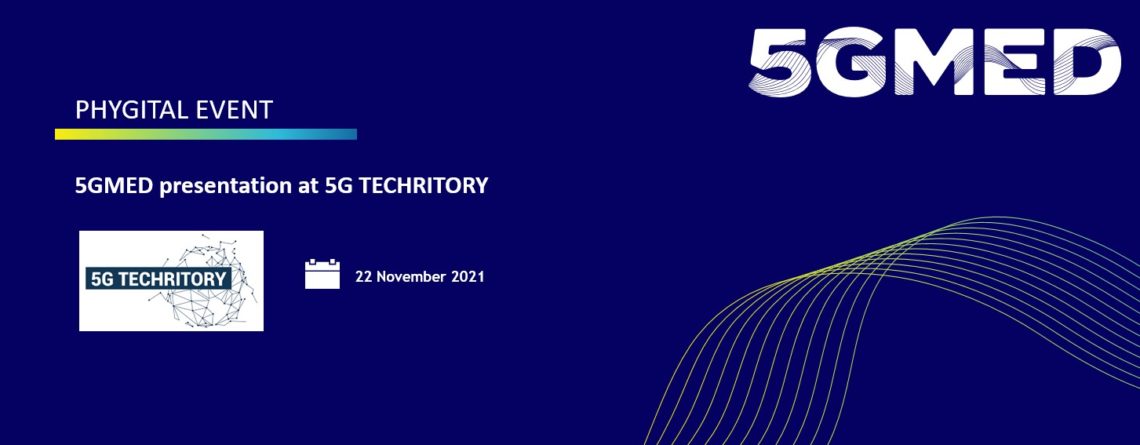5GMED at the 5G TECHRITORY FORUM
5GTechritory event gathered the European 5G experts virtually to answer some of the essential questions about 5G. On the first day of Europe’s leading 5G ecosystem forum, invited 5GMED partners talked about the challenges and opportunities of the cross-corridor project.
On the 21st of November 2021, the panel organised by 5G Techritory was an opportunity for the 5GMED project to be presented. Project coordinator, Raül Gonzalez Prats (Cellnex) gathered two project partners, Pierre-Yves Petton (SNCF) and Xavier Daura (Abertis), for a panel focused on the 5G impacts on the automotive and railway sector and the synergies between those sectors. Xavier Jofre (MWC) moderated the panel conversation. The project was introduced by the coordinator while displaying the 5GMED video presentation.

“5G technology will be the key tool to accelerate the new cooperative connected and automated mobility.”
To start the conversation, the head of innovation from MWC asked about SNCF and Abertis Autopistas use of 5G and the motivation to be part of the 5GMED project. For the head of the telecom and IoT research group at SNCF, 5G will replace other mobile technologies in the coming years to improve user experiences, ultra-reliable low latency communication, massive type communication, and to allow machine-to-machine support by design responding to the industry need. Regarding the motivation to be in the project, for Pierre-Yves Petton, 5GMED can inspire changes in the railway telecommunication paradigm:
“If 5gmed conclusion is positive performance on business services, we can think of the possibilities to extend 5GMED model to critical services, very disruptive approach as the common view is that the infrastructure manager has to deploy their private network to support critical services as they are linked to security.”
Xavier Daura, from Abertis, explained that 5G technology not only help Abertis Autopistas to understand the opportunities of 5G for road operators but also accelerates the deployment of 5G in the European corridors. In the use case 1 remote driving and use case 2 in which Abertis is involved, the company has to ensure safety manoeuvres and to develop smart and cheaper sensors that will be easy to install in the future:
“The goal is to have as much of a detailed and microscopic vision of the road as possible, to generate traffic strategies, with the use of artificial intelligence algorithms. ”

For Abertis which has been working intensively for some years to understand the role of the road operator in the future of Cooperative Connected Automated Mobility (CCAM), the full automated future is still far. Nevertheless, road infrastructure will play a significant role in the increased percentage of automated and connected vehicles in real traffic. The Intelligent Transportation Systems in the future will be based on the cooperation of road infrastructure and all the connected vehicles.
Multiple possible synergies between railways and road
The coordinator of the project points towards that there are a lot of possible synergies between the two worlds from the services point of view but also from the infrastructure side:
“it is important to remark that more than 35% of those are less than 1km between rail and road common infrastructure to provide services”.

Low latency is another critical point that has been raised by Gonzalez Prats In the case of the passenger experience, SNCF added that on the highway and on the train, the passenger looks for the same, they want entertainment. Abertis listed some points where 5G can create a lot of synergies between different mobility ecosystems, not only related to mobility:
- Global 5G architecture perfectly adapted to accommodate roadways and railways or any other mobility services.
- Synergic in all these ecosystems, so that infrastructure could be shared.
- The MEC (Multi-access edge computing) brings technology resources closer to the end user. 4. Multi-stakeholder combining multiple technologies.
- Hybrid multi-stakeholder business models aimed at reducing/optimising the required investments.
“5GMED is a proof of concept, a lab that will help the deployment of the 5G for the railway and automation”
Pierre-Yves Petton argued that 5GMED is the first step of the deployment of the 5G for the railway since it will enrich the list of use cases, foreshadow the Europe funding program CEF2 digital, and connect Europe with 5G.

According to Autopistas, this European corridor will be the main infrastructure in the south of Europe with 5G technology on interurban roads. Together with other 5GMED project partners, new European or private projects related to CCAM will be developed. The objective is to increase knowledge, developments, and infrastructure digitalization to offer it to the market”. Abertis shared some opportunities through 5GMED or 5G technologies for road operators:
“5GMED help the private and public administration to understand how 5G can be deployed in interurban areas”.
According to Daura, Hybrid solutions are an opportunity for road operators or the public-private partnerships that can help to deploy 5G networks. Cellnex emphasized that 5GMED is a lab to scale the project to the 26 000 km of corridors in Europe:
“the objective is to connect better people and logistics to be more competitive as a continent”.
This panel has been an opportunity to understand the focus of the project which will be to tackle the cross-border complexity but also to identify the many synergies possible between automation and railway.
You are invited to watch the replay here


